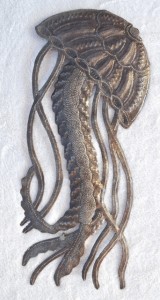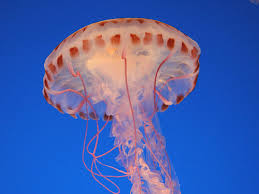Jellyfish, art and ancient warfare
Earlier this week, we posted 39 new catalogue pieces on our website. Designs that we have worked long and hard to bring about, we are now excited and proud to present. Though it is hard to pick a favorite, I’m going to. Hands down, and for the next three or four days at least, it is Kendy Bellony’s jellyfish.
Isn’t it elegant? That’s what I think of when I think of jellyfish. Elegance. I saw them in an aquarium one time and in that particular exhibit, each of the tanks was surrounded by a heavy, highly ornate, gilt frame and in the background, classical music was playing – Bach or Handel, I’m sure. It seemed entirely appropriate as I marveled at the jellies gliding with refined grace through the water on the other side of glass. Watching this video by David Regner for the National Aquarium in Baltimore took me right back to that experience. http://www.youtube.com/watch?v=aJUuotjE3u8 They are works of art, pure and simple.
Kendy’s sculpture looks to me like a sea nettle, which is a type of jellyfish found in both the Atlantic and Pacific oceans. They are characterized by their long tentacles and frilly mouth-arms (I did not make that up. That’s what they are called, according to the Monterey Bay Aquarium website.) and by the star-like pattern on the top of their bell. They eat zooplankton, small crustaceans, and other jellies, while they are preyed upon by tuna, dogfish, butterfish, sunfish, and sea turtles. Jellyfish as a species have no blood, brains, teeth, or fins and are 95% water, which sort of makes you wonder about nutritional value and why ANYTHING bothers to eat them at all. Balance of nature and circle of life considerations, I presume, or maybe just roughage…
The splendid, flowing tentacles and mouth-arms of the jellies are, of course, where the “sting” is carried. This insidious business is conducted by a multitude of stinging cells called nematocysts, which vary in toxicity from mildly irritating to deadly. Though my research resources are replete with gee-whiz facts with regard to “the sting,” this one, in my opinion takes the cake: The National Aquarium website reports that the ancient ninja warriors of Japan used to scatter dried venom from the Northern Sea Nettle into the wind to irritate the nose and eyes of their enemies during battle.
Sayonara, Baby!
Contributed by Linda for Beyond Borders/It’s Cactus







![sm407[1]](https://blog.itscactus.com/wp-content/uploads/2013/06/sm4071.jpg)